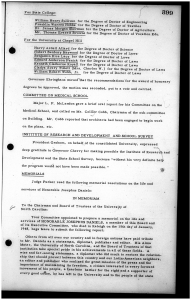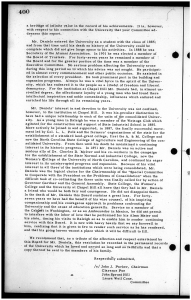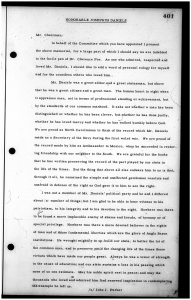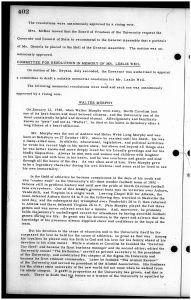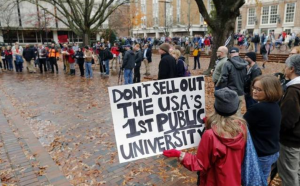Legend says that if a person sits in the pit all day, they will see every student that attends the University of North Carolina – Chapel Hill. The pit is the center of student life at UNC. The student union, two libraries, a dining hall, and the student stores surround this space. Today it is a sunken brick patio created from, quite literally, a pit of mud and dirt left by construction workers in the late 1960s.[i] While it may not be entirely true that every student walks through this space on a daily basis, it is one of the busiest areas on campus. This space as used as a pathway, a meeting space, and most profoundly a host of student activities.
Every day there are student groups promoting events they will host, performances showing off the talents of the student body, preachers, university-sponsored activities, and a whole series of others. However, with all that traffic not many people stop and look up. To most, the Frank Porter Graham Student Union is just “the Union,” the Robert B. House Undergraduate Library is just “the UL,” and the Josephus Daniels Student Stores is just “Student Stores.” The dedication of these buildings is meant to memorialize and recognize the work of their namesakes. However, when practice ignores this and names, and biographies are forgotten – how much memorialization is happening? What about when the namesakes are ardent white supremacists chosen by the Board of Trustees for memorialization specifically for those acts?
The above happened in the case of William Saunders and Saunders, now Carolina, Hall. Our story revolves around the Student Stores and another leader of North Carolina’s late nineteenth century white supremacy campaign, Josephus Daniels.
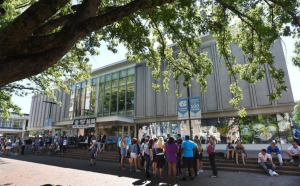
Front facade of UNC Student Stores [ii]
Biography:
Josephus Daniels was born in Washington, North Carolina in 1862 though in 1865 his mother moved the family to Wilson, North Carolina to take a job as the postal official.[iii] As a young person, Daniels worked for the local post office and the Wilson pharmacy, became extremely well educated at the Wilson Collegiate Institute, and eventually became involved in the growing newspaper business.
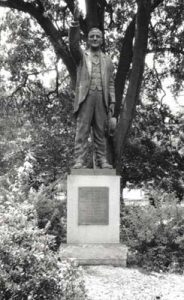
Josephus Daniels Monument, Raleigh [iv]
Edward Nadal’s influence on young Josephus Daniels is emphasized in the 2013 publication Josephus Daniels: His Life and Times. Notably, Nadal was a member and supporter of the Confederate Army and an active member of the Ku Klux Klan. The relationship that Nadal and Josephus Daniels created during summer school would continue as young Daniels developed in the small town of Wilson.[v] For Josephus Daniels, Nadal was more than just a teacher. He provided Daniels with a job at the Wilson pharmacy and continued to help in Daniels’ endeavors as he grew. Despite this close relationship, many biographical references do not include the same amount of background information on Nadal. It is evident that white supremacy reigned in the south, ignited and passed on by supporters of the Confederacy and members of the Ku Klux Klan who were often also influential members of the town. Many biographies do not mention the biased education students received from Nadal, an active member of the Ku Klux Klan, and the effect it had on society. Biographies simply speak of the positive entrepreneurial mentorship Nadal provided to Daniels.
As an adult, Daniels served as the Secretary of the Navy under Woodrow Wilson, Ambassador to Mexico under Franklin Delano Roosevelt, Editor of the Raleigh News and Observer, and University of North Carolina Trustee. He attended Trinity College (now Duke University) for his undergraduate education and then The University of North Carolina at Chapel Hill for law school. His influence, as editor, of the Raleigh News and Observer played a major role in the “white supremacy campaign” of the Democratic party.
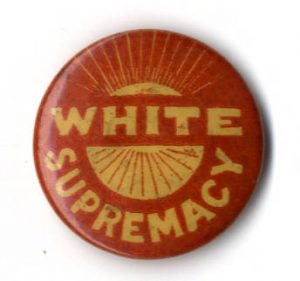
Button, white supremacy [vi]
“[o]n election day, November 8, 1898, the Democrats were returned to power. They won a majority of the seats in the legislature and quickly began work on legislation that would effectively disenfranchise African American voters for decades to come. The effects of the election were lasting. After Daniel Russell left office in 1900, North Carolina would not elect another Republican governor until 1972. George White, an African American who was elected to Congress from a predominantly African American district in 1898 was the last African American elected to that body until 1928. North Carolina would not send another African American to Washington until 1992.”[vii]
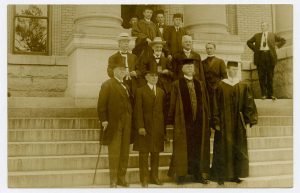
Josephus Daniels, Governor Locke Craig, Edward Kidder Graham, and others at the University of North Carolina [viii]
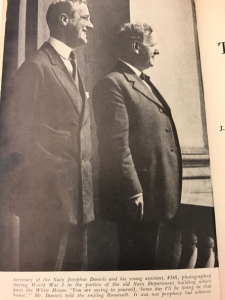
Josephus Daniels standing with then Assistant Secretary of the Navy, Franklin Delano Roosevelt [ix]
After serving almost three decades in office, Daniels returned to North Carolina in 1941 and reinstated himself at the Raleigh News and Observer. He wrote prolifically and in his late life published a 5-volume autobiography in which he commented on his role in the North Carolina Election of 1898, white supremacy campaign and on his tenure as ambassador to Mexico and Secretary of Navy.
Through his life, Daniels served on the Board of Trustees for 41 years in changing capacities. Upon his death in 1948, the University Trustees published a memorial in their minutes.
It is important to note that while Daniels was active in the politics of North Carolina, the relationship between the University and the state government was much stronger than it is today, and firmly connected to the Democratic party and the election of 1898 – the “white supremacy campaign.”
“And shortly before I was born, my father had been the man chosen by the Democratic Party in North Carolina to go all over the South and devise the best, and hopefully the most constitutional, system to disenfranchise the illiterate blacks while not disenfranchising the illiterate whites.”[xi] – Johnathan Worth Daniels
Two decades after his death, in 1968, the Board of Trustees decided to name its new Student Stores building after him. At the same time, they were building the Frank Porter Graham Student Union and the Robert B. House Undergraduate. In 1967, The Committee on Memorials and Naming Buildings proposed Daniels’ name with little grandeur.
History of Student Stores:
Since construction in the late 1960s, the Josephus Daniels Student Stores has been mostly unchanged. The facade remains in the modern style, similar to the Student Union and Undergraduate Library, built at the same time, and it continues to be a conglomeration of different stores serving student needs. Today, it is home to a coffee shop, apparel shop, post office, electronics store, pharmacy, textbook store, regular bookstore, and print shop.
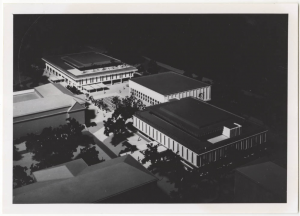
View of the Undergraduate Library, Student Union, and Student Stores before they were built [xii]
In 2016, Student Stores was privatized by Barnes & Noble College.[xv] The switch ignited many students and faculty to stand up against the change through protest though these protests did not alter the outcome of the privatization. Since the privatization, Barnes & Noble College and the Student Stores Director have begun work to update the interior and expand the use of the building to include more activity space for students and integrate it with student services that the Student Union and Pit areas provide.[xvi]
Campus Controversy:
In 2016, the student community began questioning Saunders Hall citing that it was a blatant memorialization of a prominent leader of the Ku Klux Klan chosen by the Board of Trustees for that activity. At the same time, the student community was also fighting against the privatization of Student Stores by Barnes and Noble and the Silent Sam monument which commemorated Confederate soldiers. These movements cited issues of equality, access, and the overarching power of University decisions at the sake of students and faculty. However, in the discussion of Student Stores in 2016, the biography of Josephus Daniels and the memorialization of him as an influence on the election of 1898, was not referenced. Instead, the conversation surrounded the economics of privatization, the value of university-run stores, and the livelihood of employees.
In comparing Saunders Hall and the Josephus Daniels Student Stores, there are evident differences in the biographies of both men. The main issue students faced with Saunders was that he was a white supremacist memorialized by the Board of Trustees, which Daniels served on when the building was named, specifically for that reason. However, Josephus Daniels also played a significant role in the white supremacy of North Carolina, not only did he have massive reign in the press but he served on the Board of Trustees from the 1900’s until he passed. Through his influence, at the News and Observer, he promoted the ideals of the Democratic party during the election.
“The News and Observer was relied upon to carry the Democratic message and to be the militant voice of White Supremacy, and it did not fail in what was expected, sometimes going to extremes in its partisanship.”[xviii]
In response to campus uprising about Saunders Hall, The Board of Trustees renamed the building Carolina Hall and placed a 16-year ban on changing building names so even if students were to rise again, there is a systemic barrier to making a change. The truth is that the campus of the University of North Carolina at Chapel Hill disproportionately remembers white, rich, and racist North Carolinians through the dedications of campus buildings. This truth is not surprising when put in context.
The University of North Carolina at Chapel Hill opened in 1789; it has existed through the major wars and equal rights campaigns. North Carolina is a southern state wrought with a history of racism, sexism, and a slew of hard truths.
The University’s mission statement:
“The University of North Carolina at Chapel Hill, the nation’s first public university, serves North Carolina, the United States, and the world through teaching, research, and public service. We embrace an unwavering commitment to excellence as one of the world’s great research universities.
Our mission is to serve as a center for research, scholarship, and creativity and to teach a diverse community of undergraduate, graduate, and professional students to become the next generation of leaders. Through the efforts of our exceptional faculty and staff, and with generous support from North Carolina’s citizens, we invest our knowledge and resources to enhance access to learning and to foster the success and prosperity of each rising generation. We also extend knowledge-based services and other resources of the University to the citizens of North Carolina and their institutions to enhance the quality of life for all people in the State.
With lux, libertas — light and liberty — as its founding principles, the University has charted a bold course of leading change to improve society and to help solve the world’s greatest problems.”[xix]
It does not seem that the current state of the campus, through dedications, represents that same mission.
Questions to think about:
How could the relationship with Nadal have affected Daniels’ influence in the white supremacy campaign and his outlook on society?
Daniels was a devout Methodist, often his decisions in office are traced back to religion rather than politics, how are politics and religion intertwined today? Can they ever be separated?
Can Josephus Daniels’ activity in the white supremacy campaign be outweighed by influence in other positive campaigns?
More Reading:
More information on the Election of 1898 can be found here.
Transcript of an Oral History with Johnathan Worth Daniels can be found here.
Sources:
[i] Graham, Nicholas. “A Brief History of The Pit.” History on the Hill. January 12, 2016. Accessed March 25, 2017. https://blogs.lib.unc.edu/hill/index.php/2016/01/12/a-brief-history-of-the-pit/.
[ii] Stancill, Jane. “UNC Student Stores could be outsourced to private company.” News and Observer. Accessed March 26, 2017. http://www.newsobserver.com/news/local/education/article35767662.html.
[iii] “JOSEPHUS DANIELS.” NCpedia. Accessed March 2017. http://www.ncpedia.org/biography/daniels-josephus.
[iv] Josephus Daniels Monument, Raleigh. Jpg. Smithsonian Art Inventories Catalog. Janos Farkas, Sculptor
[v] Craig, Lee A. Josephus Daniels: his life & times. Chapel Hill: The University of North Carolina Press, 2013.
[vi] Button, white supremacy. Jpg. Chapel Hill: North Carolina Collection.
Lew Powell Digital Collection
[vii] The Election of 1898 in North Carolina: An Introduction .., https://exhibits.lib.unc.edu/exhibits/show/1898/history (accessed March 24, 2017)
[viii] “[Josephus Daniels, Governor Locke Craig, Edward Kidder Graham, and others at the University of North Carolina]” Durwood Barbour Collection of North Carolina Postcards (P077), North Carolina Collection Photographic Archives, Wilson Library, UNC-Chapel Hill
[ix] Daniels, Jonathan. The end of innocence. New York: Da Capo Press, 1972.
[x] “Memorials” in the University of North Carolina Papers (#40002), Trustee Minutes Volumes 3-5, University of North Carolina at Chapel Hill.
[xi] Daniels, Johnathan Worth. “Interview with Jonathan Worth Daniels, March 9-11, 1977. .” Interview by Charles Eagles. Documenting the American South. http://docsouth.unc.edu/sohp/playback.html?base_file=A-0313&duration=09:52:17.
[xii] Daniels Building: Exterior. University of North Carolina at Chapel Hill Image Collection, 1799-1999, UNC – Chapel Hill, Chapel Hill.
[xiii] “Student Stores.” The University of North Carolina at Chapel Hill. Accessed March 2017. http://www.unc.edu/interactive-tour/student-stores/.
[xiv] Fieulleteau, Jordan. “UNC Student Stores and the Story Behind its Name.” The Arc. February 14, 2016. Accessed March 22, 2017. http://yblog.web.unc.edu/784-2/.
[xv] Jackson, Acy. “Barnes & Noble College will take over UNC Student Stores on July 1.” The Daily Tar Heel. April 21, 2016. Accessed March 22, 2017. http://www.dailytarheel.com/article/2016/04/barnes-noble-college-booksellers-will-operate-unc-student-stores-starting-this-summer-on-july-1.
[xvi] Rardin, Nic. “Plans for Student Stores renovation include study space and food options.” The Daily Tar Heel. March 23, 2017. Accessed April 2017. http://www.dailytarheel.com/article/2017/03/plans-for-student-stores-renovation-include-study-space-and-food-options.
[xvii] Stancill, Jane. “UNC to outsource its bookstore to Barnes & Noble.” News and Observer. Accessed March 24, 2017. http://www.newsobserver.com/news/local/education/article73165067.html.
[xviii] Graham, Nicholas. “Josephus Daniels.” The 1898 Election in North Carolina. Accessed March 2017. https://exhibits.lib.unc.edu/exhibits/show/1898/bios/daniels.
[xix] “Mission.” The University of North Carolina at Chapel Hill. Accessed March 25, 2017. http://www.unc.edu/about/mission/.

